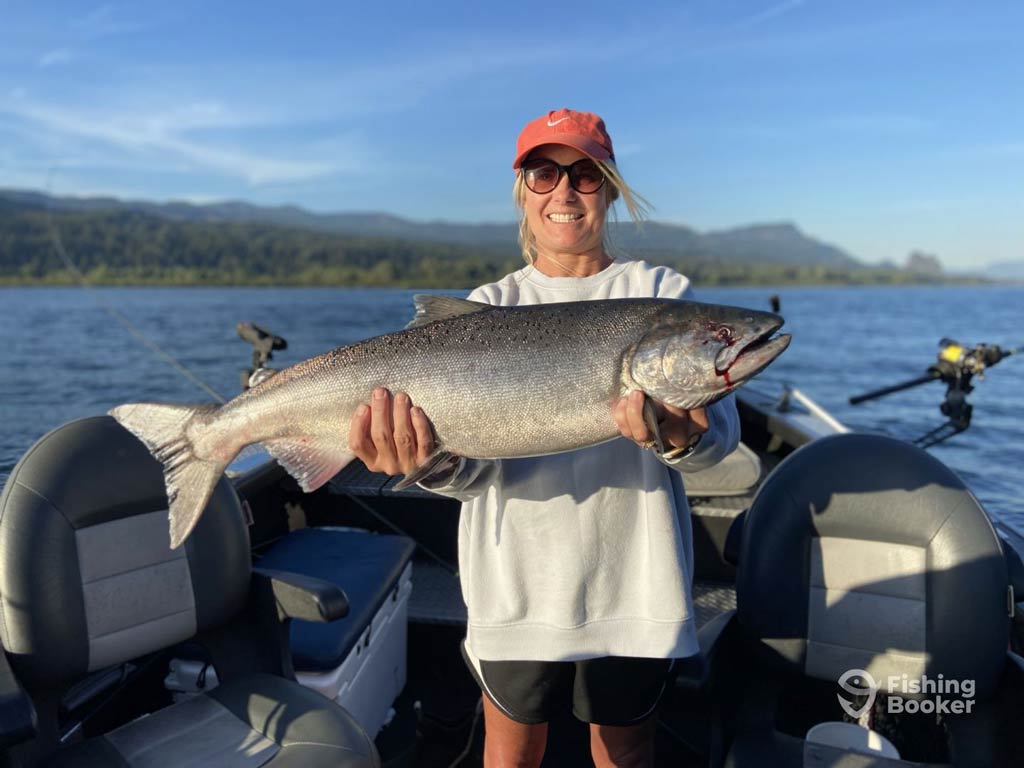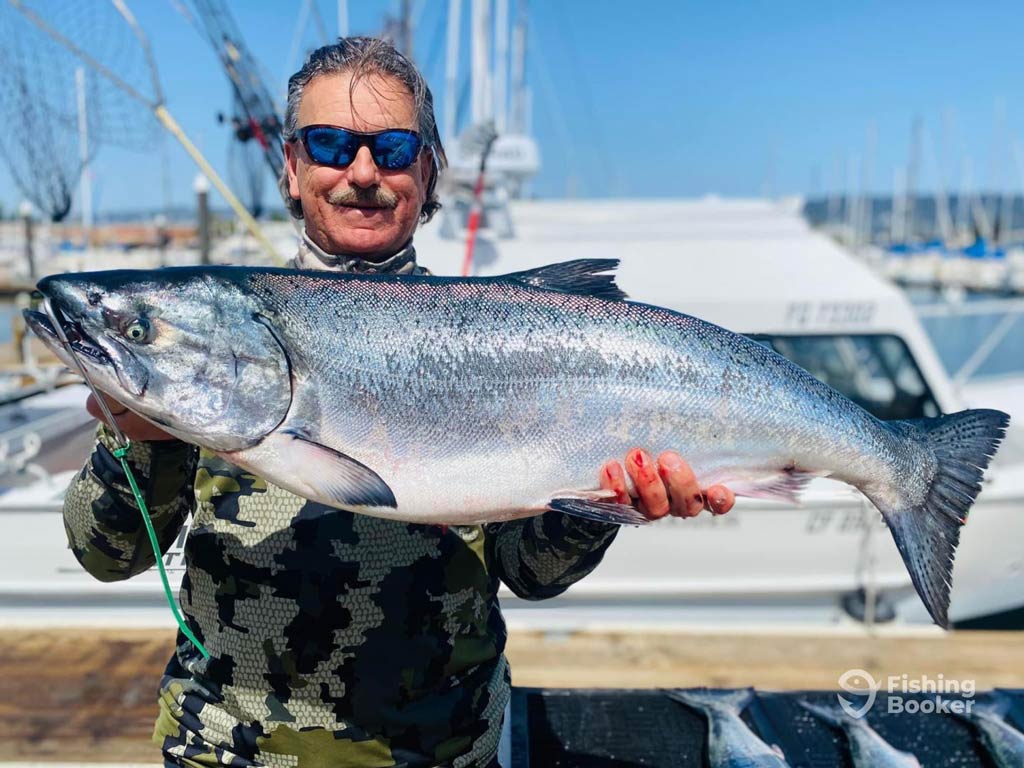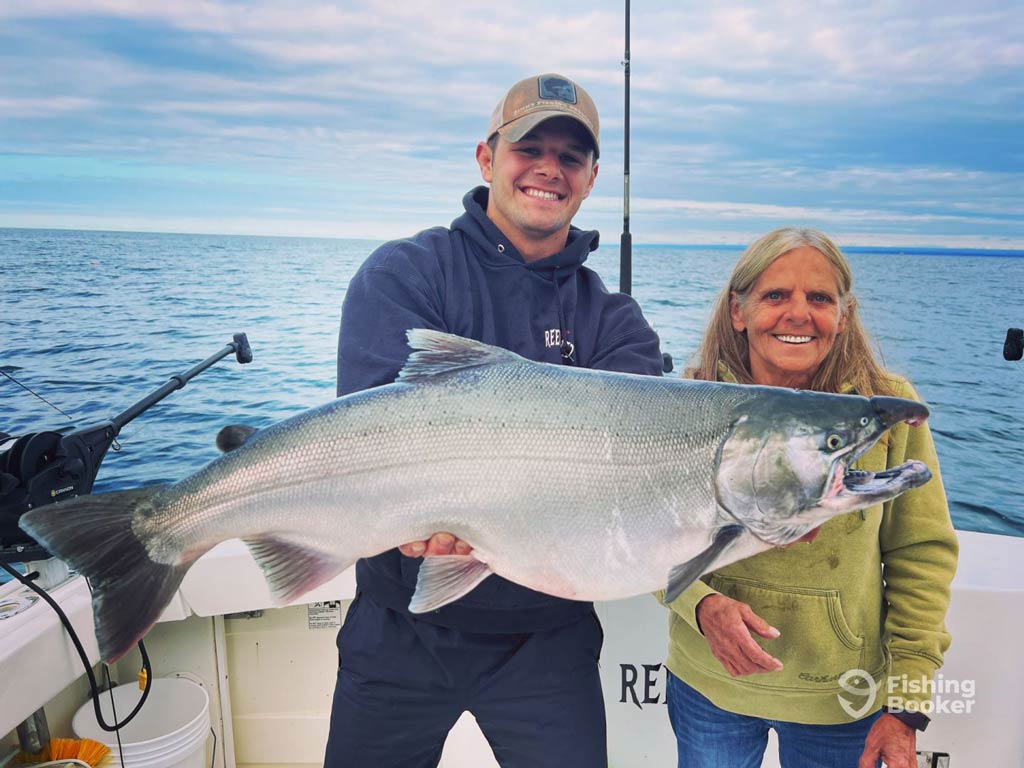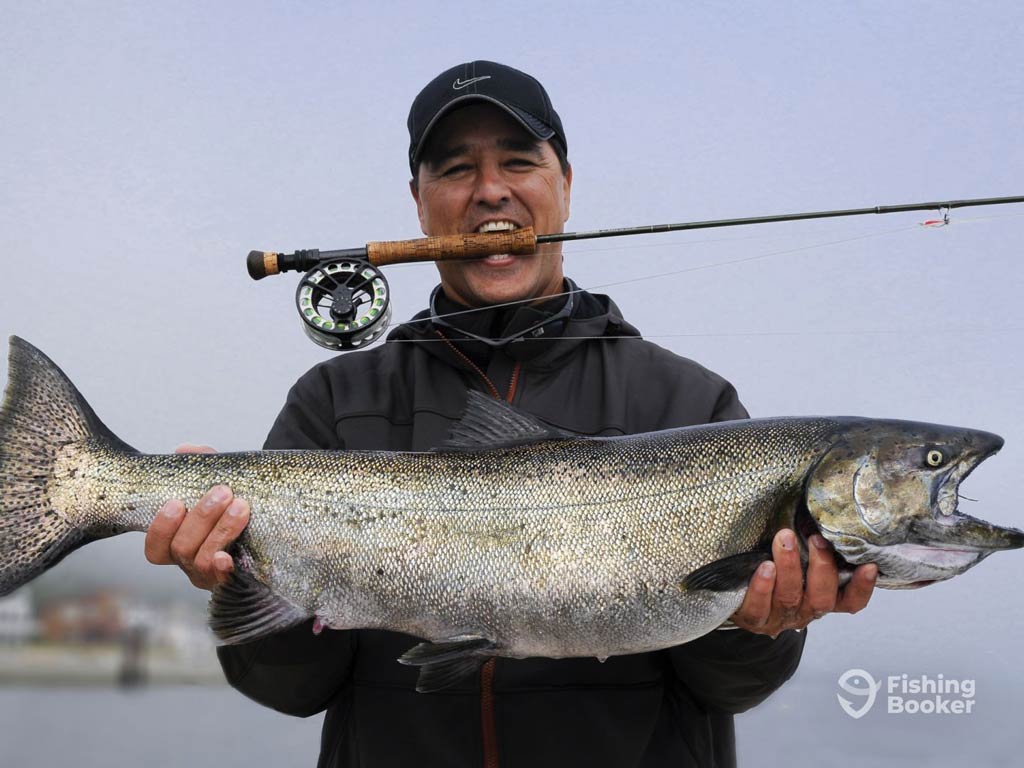Reading Time: 7 minutesBe it rod-bending action or the need for a smart strategy, a challenge is guaranteed when you go Salmon fishing. Salmon are worthy rivals that rank high on every angler’s list. It comes as no surprise, then, that we need an entire guide dedicated to these majestic creatures. But what will this piece cover?

Photo taken by Shirley Catch Guide ServiceBesides diving into the world of Salmon varieties and talking about the top reasons to fish for them, expect to learn about fishing tips and tricks too. We’ll also share guidelines on how to navigate seasonality and fishing regulations. Last but not least, you’ll find a list of hotspots and blog posts on how to fish for Salmon in those locations. There’s a lot to unpack, so let’s get started.
What are you interested in?
Salmon Varieties
No freshwater fish are as famous as Chinook “King” Salmon. Even if you’ve never fished before, you’ve probably heard of them. But did you know that there are more than five officially recognized Salmon varieties? In fact, there are seven species of Pacific Salmon - five of which inhabit North America (Chinook, Coho, Chum, Sockeye, and Pink), while two live in Asia (Masu and Amago). There’s also one Atlantic Salmon. Let’s take a closer look at the most popular species…
- Chinook Salmon. Better known as King Salmon, these fish are royals for a reason. They’re the largest Salmon species, reaching up to 5 feet in length and weighing almost 130 pounds! And that’s not all. They’re also the predominant Salmon variety in North America.
- Coho Salmon. Aka Silver Salmon, these fish don’t reach the epic proportions of King Salmon, but they’re famous for their fighting abilities, so don’t discard them too quickly. What they lack in size, they certainly make up for in performance.
- Chum Salmon. The same as Coho Salmon, Chum Salmon inhabit the waters between Alaska and California. However, unlike Chinook and Coho, Chum cannot be found in the Great Lakes and they’re sometimes referred to as “Dog Salmon” because they don’t taste well but fight just as much as the other varieties.
- Sockeye Salmon. Speaking of flavor, there’s no doubt that Sockeye Salmon are the tastiest of them all. They’re also the most distinctive Salmon variety due to their dramatic changes in color and bright red hues during their spawning season.
- On top of all this, Sockeye Salmon are fascinating because they also have a landlocked form called Kokanee Salmon. Unlike Sockeyes, Kokanees spend their entire lives in freshwater and, while smaller, are pretty much exactly the same in every other sense.
- Pink Salmon. If Chinook are the largest, Coho are the feistiest, Chum are the most underrated, and Sockeye are the most delicious, then Pinkies have the reputation of being the smallest but the most energetic. Plus, they have enviable shape-shifting abilities, so don’t be surprised if you see spawning males with a hump on their backs.
- Atlantic Salmon. As the name suggests, Atlantic Salmon are native to the Atlantic Ocean, and you should be able to catch them between Connecticut and Quebec. However, you’ll have the biggest chance of landing a decent Atlantic Salmon in the Lake Ontario region.
Last but not least, let’s not forget about Trout and Arctic Char. Why, you ask? Well, these two species are commonly mistaken for Salmon. To learn more about the differences and similarities between them and Salmon, check out our Trout vs. Salmon and Arctic Char vs. Salmon blog posts.
Reasons to Fish for Salmon

Photo taken by Pacific Angler SportfishingSalmon are fascinating creatures on so many levels. Be it their magical transformations or sport fish characteristics, the reasons to love and fish for Salmon are numerous. It’s no wonder they’re among the most sought-after species in the angling community. But let’s see what makes them desirable catches:
- Game Quality. Depending on what Salmon variety you want to target, you’ll come across a range of different fighting skills. Chinook will make you break a sweat, while Coho Salmon will spice up your angling experience with acrobatic leaps. And the tiniest of all Salmon species, Pink Salmon, won’t go down without a fight either.
- Availability. Salmon are both a freshwater and saltwater species. They spend their lives out in the open before returning inland to spawn. This means you’ll find them anywhere from ocean and bay waters to river and lake fisheries. The fact that Salmon are widespread unlocks angling opportunities for you whether you’re fishing in Alaska, Connecticut, the Great Lakes, Japan, or Russia!
- Looks. There’s no denying that Salmon are good-looking. From their silvery and shiny armor to their patterned and crimson-red bodies, these fish are dressed to impress. And who can resist snapping a photo with such beauties? We know we can’t.
- Taste. If you’re more into their lip-smacking qualities, don’t worry - Salmon dominate here, too. Chinook, Coho, Sockeye, Pink, and Atlantic Salmon promise a culinary delight. Sockeye’s rich flavor, in particular, is unsurpassed.
- Trophy Fish. We can’t tell if Salmon are more alluring because of their game fish qualities, picture-perfect traits, or table fare flare. Luckily, there’s no need to choose between them because when you go Salmon fishing, you’re in for all of those things. And this is exactly what makes them brag-worthy catches.
Salmon Fishing Seasons

Photo taken by Reel Addicted ChartersAngling for Salmon requires you to experiment with different angling methods, test various baits and lures, and hit the right hotspots. But most importantly, you have to nail the timing. And this is anything but simple.
The Salmon fishing season typically runs between late spring and early fall, with summer as the peak season. But this isn’t a rule of thumb, and seasonality may vary depending on the location and species. For example, the best time to fish for Salmon in Alaska’s Kasilof River is from mid-May to mid-September, whereas the Kasilof River’s Cohos are later bloomers, with mid-August as their prime time.
Meanwhile, Lake Michigan’s Chinook Salmon shine the brightest during their annual run between late July and September, while Coho steal the spotlight in June. So, the only way to be sure your Salmon is in high season is to double-check the rules and regulations of the place where you plan to pursue your target. But more on that below.
Best Salmon Fishing Spots
Being widespread saltwater and freshwater species, Salmon are available in an endless number of hotspots. In the US, you can find them everywhere from Alaska to Connecticut. This makes it very difficult to narrow the list of the best Salmon fishing spots down to only a couple of corners. Instead, we’ll share a list of the best states and bodies of water to check out.
Each link below leads to a comprehensive guide that outlines the best hotspots, fishing techniques, seasons, and regulations for that specific location.
Best Salmon Fishing States
Best Salmon Fishing Regions
Salmon Fishing Tips
Ask a few Salmon aficionados for a piece of advice on how to fish for Salmon, and the chances are that each angler will give you a different answer. But they’ll most likely all be correct! This is because there isn’t a single approach to outwitting Salmon. You have to mix and match baits, lures, and methods until you find the winning combo.
For ideas on how to go about landing these beasts, check out the following blog posts:
Trolling and fly fishing are among the most popular angling techniques when fishing for Salmon. However, drift fishing, plunking, and float fishing aren’t lagging far behind either. And if you want to try something new and exciting, go for mooching. Mooching is a saltwater fishing practice of attracting Salmon with cut herring by imitating the movement of a wounded bait.
Speaking of baits and lures, you can use anything from flies, herring, fish eggs, and worms to spinners, spoons, and paddle tails. But these also vary depending on the fishing technique or fishery you want to conquer. Dry and wet flies, for example, are suitable for fly fishing, whereas herring is perfect for mooching.
Last but not least, when it comes to your choice of equipment, medium-heavy rods and reels are recommended due to the impressive weights and sizes Salmon can reach.
Salmon Fishing Regulations
Where there’s high demand, there are rules to curb overfishing, too. It’s not surprising, then, that Salmon angling is heavily regulated. There are strict seasons, size and bag limits, and even equipment rules you have to follow. And each location has its own set of rules and regulations you have to respect if you want to fish for Salmon.

Photo taken by A Spot Tail Salmon GuideAlong with the mandatory fishing license, you’ll find seasonal regulations and bag and size limits among the most important rules to remember. The season usually runs from spring to fall and you may keep up to five fish, but the season won’t be open everywhere at the same time, and Salmon won’t always be up for grabs. Nova Scotia, for example, allows only catch-and-release fishing. Meanwhile, the Columbia River has a daily limit of two fish.
The wisest thing you can do is to go to the official website of the Fish and Wildlife Agency of the state, country, region, or body of water where you plan to fish for Salmon and see what rules and regulations you must adhere to prior to wetting your line in their waters. Here’s a list of agencies you can check out:
Salmon Fishing FAQs
Salmon is both a freshwater and saltwater fish. They’re generally born in freshwater, but then they spend part of their lives in saltwater before returning to the rivers and streams for spawning.
While there isn’t a single correct answer to this question, summer is considered to be the best time to fish for Salmon, as the warmer months usually coincide with their peak season.
You can fish for Salmon anywhere from Alaska, Washington, Oregon, and Wisconsin to Canada, Russia, Norway, and New Zealand, including ocean waters, estuaries, bays, rivers, streams, and lakes.
Salmon eat flies, herring, fish eggs, and worms, so you can use all of those as bait when fishing for Salmon, along with plenty of imitations.
The post Salmon Fishing: The Complete Guide for 2024 appeared first on FishingBooker Blog.
https://fishingbooker.com/blog/salmon-fishing-the-complete-guide/
 CampingSurvivalistHuntingFishingExploringHikingPrivacy PolicyTerms And Conditions
CampingSurvivalistHuntingFishingExploringHikingPrivacy PolicyTerms And Conditions
